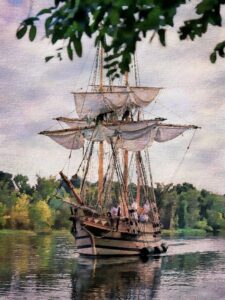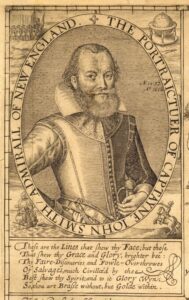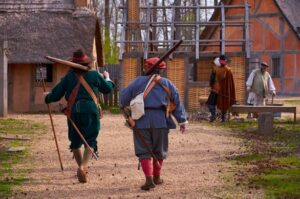The first permanent English settlement in North America is founded at Jamestown. This marked the beginning of English colonization in North America. The Virginia militia itself dates back to 1607, established as part of the English militia system in the colonies.
Article by Henricus Historical Park Staff
On December 20, 1606, 144 English men and boys departed London on-board three small sailing ships with orders from the Virginia Company to create a colony in the New World. After storms detained them in England for a few weeks, the expedition set off  and by a circuitous path through the West Indies sailed into the Chesapeake Bay in April. By May 14, 1607, they founded Jamestown on an uninhabited inland location, naming the town and its adjacent river after their king: James I. Although not the first English attempt to launch new settlements in the Americas, this endeavor established the first permanent English settlement in North America and subsequently marks a foundational moment in American history.
and by a circuitous path through the West Indies sailed into the Chesapeake Bay in April. By May 14, 1607, they founded Jamestown on an uninhabited inland location, naming the town and its adjacent river after their king: James I. Although not the first English attempt to launch new settlements in the Americas, this endeavor established the first permanent English settlement in North America and subsequently marks a foundational moment in American history.
It certainly was no easy start. Issues burdened the settlement at Jamestown from day one. As George Percy, a president of the colony, remarked “There were never Englishmen left in a forreigne Countrey in such miserie as wee were in this new discovered Virginia.” Jamestown Island might have been defensible against the Spanish, the English’s main European rival, but it proved marshy and mosquito infested—an altogether horrible place to found a new town. Already by late June 1607, disease and famine ravaged the colony, and few men remained healthy due to the unfamiliar climate and brackish water that was in the words of Percy “full of slime and filth.” To compound these issues, food supplies reached dangerously low levels as many colonists searched for gold and other commodities instead of planting crops. Political in-fighting and discipline problems further blighted most attempts to harness colonists’ labor for the purpose of food production. This lack of foresight and leadership hurt Jamestown and killed many early colonizers.
 Through the assistance and gifts of the Powhatan, the Algonquian-speaking chiefdom that dominated the coastal region of Virginia, and the leadership of Captain John Smith, Jamestown survived its first years. Smith facilitated a beneficial trading arrangement with the Powhatan, securing much needed supplies of food. He also began to enforce discipline more regularly—famously remembered in the maxim “He that will not worke shall not eate.” By 1609, however, the situation at Jamestown soured once more. Injured by political enemies in a gunpowder incident, John Smith left the colony, and relations with the Powhatans soured as the English became increasingly aggressive over trading for food.
Through the assistance and gifts of the Powhatan, the Algonquian-speaking chiefdom that dominated the coastal region of Virginia, and the leadership of Captain John Smith, Jamestown survived its first years. Smith facilitated a beneficial trading arrangement with the Powhatan, securing much needed supplies of food. He also began to enforce discipline more regularly—famously remembered in the maxim “He that will not worke shall not eate.” By 1609, however, the situation at Jamestown soured once more. Injured by political enemies in a gunpowder incident, John Smith left the colony, and relations with the Powhatans soured as the English became increasingly aggressive over trading for food.
These tensions led to the first Anglo-Powhatan War (1609-1614) and a siege of Jamestown. The settlers, cut off from trade and penned in their fort by Powhatan combatants, suffered horribly in the infamous “Starving Time” in winter 1609-1610. Some went so far as to consume dogs, horses, snakes, shoe leather, and even their neighbors. The situation worsened to such a degree that Jamestown was nearly abandoned in June 1610. Only the timely arrival of a supply fleet from England carrying more men and provisions saved the colony and secured the fort. Though the settlement’s hardships were far from over, Jamestown had survived its most trying time, and the re-stocked English were now prepared to go on the offensive against their Powhatan foes in the first Anglo-Powhatan War.
For the rest of the seventeenth century, Jamestown served as the capital of the Virginia colony and the place where Virginia’s General Assembly, the first representative legislative body in English America, met consistently from 1619 until the seat of government moved to Williamsburg in 1699. Ultimately, Jamestown proved central to the success and tenor of England’s colonial venture in America.

